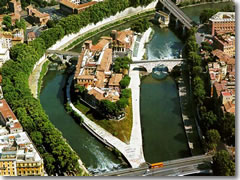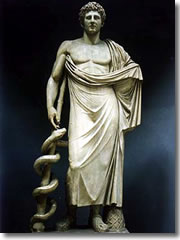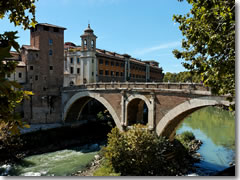

The Tiber River has only one island. It is shaped vaguely like a long, curved boat plowing through the wide waters of the S-bend at the heart of the city—and in ancient times it was avoided as a cursed spot.
For centuries the Tiber Island was popularly, if erroneously, believed to have formed around the body of the hated King Tarquin Superbus, whose overthrow (and tossing into the Tiber) led to the founding of the original Roman Republic in 509 BC.
All this changed in 291 BC. In that year, Rome was visited by a terrible plague, so the Senate voted to build a temple to Aesculapius, the god of healing.
They sent a delegation to Greece to obtain a statue of the god, and while it sailed back up the Tiber with its holy cargo, an enormous snake suddenly dropped off the decks, swam through the waters, and slithered up onto the supposedly haunted Tiber Island.
You or I might think this would clinch the island's creepiness quotient, but to the ancients it was a portentous and positive sign from the gods—specifically, from Aesculapius himself, to whom snakes was sacred (more on that in a minute).
The Temple of Aesculapius was dutifully built upon the island, a sacred spring was discovered and was believed to have healing powers, and the formerly shunned island became a place of worship and pilgrimage site for the afflicted.

To see for yourself, you can cross the ancient Ponte Fabricio, built in 62 BC and the only Roman-era bridge over the river to survive intact—though portions of the other bridge, Ponte Cestio leading from the island on into Trastevere, are also ancient.
(From the downstream end of the island, you can also see the Ponte Rotto, a broken section of ancient bridge now scenically stranded in the middle of the Tevere.)

Throughout the Middle Ages, the afflicted continued to flock to bathe in the waters of that holy spring—which remains, in a marble well, inside the Basilica of St. Bartolomeo all'Isola (www.sanbartolomeo.org), which was raised over the site of the original temple in AD 998.
Floods and other damage caused the church to be largely reconstructed in 1557, though the original Romanesque bell tower remains, as do a dozen columns (and some statues) inside that were recycled from the ancient Roman temple itself.
The body of St. Bartholomew the Apostle rests under the altar—though in 2002 the basilica was additionally dedicated to Pope John Paul II's Nuovi Martiri, the "new martyrs" of the 20th century.
The church is open Mon-Sat 9am–1pm and 3:30–5:30pm, Sun 9am–1pm. Mass is held Sundays at 11:30am, with a prayer session weekdays at 8:30pm.
The church shares the island with the Hospital of Fatebenefratelli (named for the felicitously nicknamed 'Do-Good-Brothers' order of medical monks), founded in 1548 and still going strong. But the placement of a hospital on an island sacred to Aesculapius, the Greco-Roman god of healing, isn't the only echo down through the ages.
To this day, modern doctors all around the world continue to do their good works under the banner of Aesculapius.
The Hippocratic Oath may no longer begin with its original words "I swear by Apollo the Physician and by Aesculapius...," but modern physicians have taken as their own sacred sigil the ancient god's totem: his staff, entwined with a serpent—the symbol, among many other things, of the American Medical Association.
 (Actually, some things do get lost in the translation over thousands of years. Some medical institutions—including, embarassingly, the U.S. Army Medical Corps—erroneously make use of a highly similar ancient symbol, Mercury's caduceus—a winged staff entwined with two snakes—instead of the actual symbol of Aesculapius—a single serpent wound around a plain staff. Since Mercury is, among other things, the god of thieves, I assume most of the modern institutions making this mistake are probably HMOs.)
(Actually, some things do get lost in the translation over thousands of years. Some medical institutions—including, embarassingly, the U.S. Army Medical Corps—erroneously make use of a highly similar ancient symbol, Mercury's caduceus—a winged staff entwined with two snakes—instead of the actual symbol of Aesculapius—a single serpent wound around a plain staff. Since Mercury is, among other things, the god of thieves, I assume most of the modern institutions making this mistake are probably HMOs.)
Ponte Cestio
tel. +39-06-0608
www.060608.it
Daily 24/7, though the church closes at lunchtime.
Free
Bus: 23, 125, 280, 63, 810, N8, N10, N11
Metro: Circo Massimo (B)
Hop-on/hop-off: Piazza Venezia
Planning your day: The island is something you cross, or look at from the shore, or maybe take 20 minutes to walk down along it's prow-like travertine ends and gaze across the waters of the river to the embankments of Rome on both sides. It's also a fine spot for dinner at Sora Lella.
Take a guided tour of Tiber Island with one of our partners:
In summer, they screen movies on an outdoor screen set up on the island. Its a lovely setting, regardless of what film is playing (or what language it is in).
Share this page
Search ReidsItaly.com
Ponte Cestio
tel. +39-06-0608
www.060608.it
Daily 24/7
Free
Bus: 23, 125, 280, 63, 810, N8, N10, N11
Metro: Circo Massimo (B)
Hop-on/hop-off: Piazza Venezia